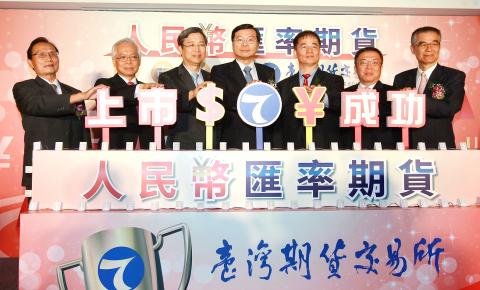Taiwan yesterday launched its first yuan futures contracts on the Taiwan Futures Exchange (TAIFEX) in the government’s latest efforts to make Taiwan a regional offshore trading hub of the Chinese currency.
“The launch of the new yuan currency futures contracts will leverage Taiwan’s advantages over other major offshore renminbi clearing centers such as Hong Kong and London,” Financial Supervisory Commission (FSC) Chairman William Tseng (曾銘宗) told an investor conference in Taipei.
These advantages include the considerable inflow of yuan earned by the vast number of Taiwanese businesses operating in China, which has propelled domestic yuan deposits to more than 338.2 billion yuan (US$54.4 billion), and the sizeable circulation of other yuan-denominated products such as Formosa bonds and insurance policies, Tseng said.

Photo: CNA
TAIFEX chairman Liu Len-yu (劉連煜) said that the two futures contracts are the first foreign exchange products to be listed since the exchange’s founding in 1998.
The contracts are listed as the RTF and the RHF.
The RTF has a contract size of US$20,000 and settlement prices based on the US dollar to yuan spot rate (CNT) set by the Taipei Foreign Exchange Market Development Foundation.
It is designed for domestic retail investors more familiar with the CNT rate.
The RHF has a contract size of US$100,000, and settlement prices based on the US dollar and yuan fixing by the Treasury Markets Association of Hong Kong (CNH) and is meant for institutional investors who are more accustomed to the association’s rate.
“Investors will find that the price spread of these contracts will be very similar to listings on Bloomberg, and much more favorable than what they can obtain from local banks,” said Harry Yen (顏輝煌), director-general of the central bank’s Department of Foreign Exchange.
It is hoped that a more complete product offering will provide traders with more investment and hedging opportunities, and most importantly, an avenue for yuan reflow, Liu said.
Trading of the futures will be facilitated by eight market makers, including four domestic futures proprietary merchants, two domestic banks and the Taipei branches of Bank of China (中國銀行) and China Construction Bank (中國工商銀行), which are acting in the capacity of institutional investors.

Taiwanese suppliers to Taiwan Semiconductor Manufacturing Co. (TSMC, 台積電) are expected to follow the contract chipmaker’s step to invest in the US, but their relocation may be seven to eight years away, Minister of Economic Affairs J.W. Kuo (郭智輝) said yesterday. When asked by opposition Chinese Nationalist Party (KMT) Legislator Niu Hsu-ting (牛煦庭) in the legislature about growing concerns that TSMC’s huge investments in the US will prompt its suppliers to follow suit, Kuo said based on the chipmaker’s current limited production volume, it is unlikely to lead its supply chain to go there for now. “Unless TSMC completes its planned six

Intel Corp has named Tasha Chuang (莊蓓瑜) to lead Intel Taiwan in a bid to reinforce relations between the company and its Taiwanese partners. The appointment of Chuang as general manager for Intel Taiwan takes effect on Thursday, the firm said in a statement yesterday. Chuang is to lead her team in Taiwan to pursue product development and sales growth in an effort to reinforce the company’s ties with its partners and clients, Intel said. Chuang was previously in charge of managing Intel’s ties with leading Taiwanese PC brand Asustek Computer Inc (華碩), which included helping Asustek strengthen its global businesses, the company

Power supply and electronic components maker Delta Electronics Inc (台達電) yesterday said second-quarter revenue is expected to surpass the first quarter, which rose 30 percent year-on-year to NT$118.92 billion (US$3.71 billion). Revenue this quarter is likely to grow, as US clients have front-loaded orders ahead of US President Donald Trump’s planned tariffs on Taiwanese goods, Delta chairman Ping Cheng (鄭平) said at an earnings conference in Taipei, referring to the 90-day pause in tariff implementation Trump announced on April 9. While situations in the third and fourth quarters remain unclear, “We will not halt our long-term deployments and do not plan to

The New Taiwan dollar and Taiwanese stocks surged on signs that trade tensions between the world’s top two economies might start easing and as US tech earnings boosted the outlook of the nation’s semiconductor exports. The NT dollar strengthened as much as 3.8 percent versus the US dollar to 30.815, the biggest intraday gain since January 2011, closing at NT$31.064. The benchmark TAIEX jumped 2.73 percent to outperform the region’s equity gauges. Outlook for global trade improved after China said it is assessing possible trade talks with the US, providing a boost for the nation’s currency and shares. As the NT dollar